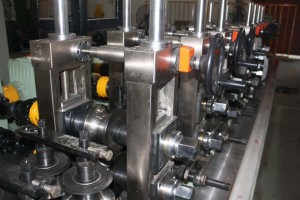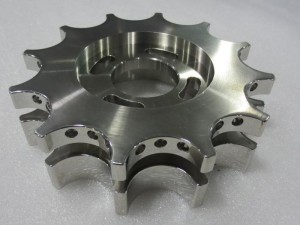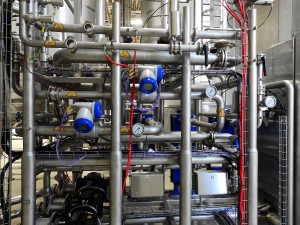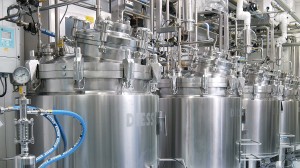Knowledge
Stainless Steel
Stainless Steel
The term “Stainless” was pitched early when steels were used in cutlery applications. Now, the stainless steel is also known as “Inox” or “Inox steel”.
Basically, it’s an alloy of 10.5% Chromium and Iron. Although Iron is the main component of the alloy, Chromium helps produce a sleek layer of Chromium Oxide over the surface of the steel structure and the layer is known as “passive layer”.
This layer prevents further corrosion on the surface. The more chromium is added to the metal, the more resistance you get to oxidation and corrosion. Besides, the stainless steel contains Manganese, Silicone and a good amount of Carbon.
For enhanced formidability and few other useful properties, Molybdenum and Nickel may be added.
At FMB Trading And Engineering, these materials are likely to be treated and process by laser cutting, metal bending, metal rolling and metal fabrication methods with relations to mild steel, stainless steel and aluminium.
Applications of Stainless Steel
Inox or Stainless steel is a versatile material, which was primarily used for cutlery but soon proved its worth in different industries like chemical, automobile etc. Its adaptation was mainly because of the corrosion resistant characteristics. But nowadays, stainless steel is not being recognized for its corrosion resistance characteristic only. Other mechanical characteristics of this highly efficient material are getting recognition and they are getting into use for production of metal products to make them more durable, efficient and oxidation resistant.
That’s why newer applications of Stainless Steel is being brought to light and here are some successful attempt to use Stainless Steel in different industries.
Kitchenware and Cutlery
The most known and notable application of Stainless steel is for cookware sets and other kitchen appliances. Specially manufactured 420 and 410-grade steel is used to make the finest cutlery, especially for the knives because they keep the edges sharp for a long time. For the forks and spoons, 304-grade steel is used, mostly the ductile 18/8 ones, containing 18% Chromium and 8% Nickel.
Power Generation Industries
Stainless Steel is used in power generation industry for of its corrosion resistant characteristics at a high temperature. The low cobalt ones are adopted in nuclear plants. Ventilation shafts are made of stainless steel, which is used in emergencies to seal off power plants for years. Besides, Gas and Steam turbines are also made from stainless steel, because of their heat and corrosion resistant qualities.
Chimerical, Gas and Oil Industry
Chemical, Gas, and Oil processing industry has the most demand for stainless steel. Their valves, pumps, tanks, and pipes are made of stainless steel, especially grade 304. This particular grade of stainless steel is more robust than its ancestors. Apart from this one, other special grade steels are made for sewage plants, harbour supports, ship propellers, offshore oilrigs and desalination plants.
Architecture
Stainless steel roofing, facades, and cladding are new footprints of modern architecture. They are adopted in architecture for many reasons, mainly because of the anti-vandal characteristics and low-maintenance cost. It is a better replacement for carbon steel to extend the life cycle of any infrastructure.
Food Production
Stainless steel doesn’t make any impact on the taste of the food and they are easily cleanable. That’s why, inox is used for food production process, especially 316 for harsh environment and 304 for regular environment.
Automobile
For structure, exhaust system, and catalytic converter, the use of stainless steel is increasing exponentially in the automobile industry. Lesser environmental impact, low and longtime maintenance cost, minimum life cycle cost, etc. are the reasons why the market for stainless steel is getting bigger and bigger.
Medical
For artificial hips and other implants, clean melted stainless steel is used. Cabinets, orthopaedic beds, examination machines etc. made of standard stainless steel because they are hygienic and easy to clean. The pharmaceutical industry uses stainless steel for hoppers and pill funnels for piping solution and cream.
Types of grade of Stainless Steel
Basically, chromium and nickel are added to carbon steel and that’s how we get stainless steel for use. But other components like manganese, molybdenum, silicon, carbon, and vanadium are also mixed with it. This mixture of different elements makes up a 3 digit number that is broadly categorized into 4 grades.
200 series
The mixture of 7% manganese, 4% nickel and 17% chromium in the steel, makes 200 –series stainless steel. It has an austenitic structure, which refers to its crystalline structure. This steel weld easier compared to other steels and it becomes magnetic after heating.
Here are some most used stainless steel type form 200 series:
201 Stainless Steel
Chemical Composition of 201 Stainless Steel
|
Element |
Quantity (%) |
| Iron | 72 |
| Chromium | 16-18 |
| Nickel | 3.5-5.5 |
| Manganese | 5.5-7.5 |
| Silicon | 1 |
| Nitrogen | 0.25 |
| Carbon | 0.15 |
Physical Properties of 201 Stainless Steel
|
Properties |
Imperial |
Metric |
| Density | 0.284 lb/in3 | 7.86 g/cm3 |
| Tensile Strength | 99400 psi | 685 MPa |
| Yield Strength | 42400 psi | 292 MPa |
| Elastic Modulus | 28573 ksi | 197 GPa |
| Poisson’s Ratio | 0.27-0.30 | 0.27-0.30 |
202 Stainless Steel
Chemical Composition of 202 Stainless Steel
|
Element |
Quantity (%) |
| Iron | 68 |
| Chromium | 17 – 19 |
| Nickel | 4 – 6 |
| Manganese | 7.5 – 10.5 |
| Silicon | ≤1 |
| Nitrogen | ≤ 0.25 |
| Carbon | ≤ 0.15 |
| Phosphorus | ≤ 0.06 |
| Sulphur | ≤ 0.03 |
Physical Properties of 202 Stainless Steel
|
Properties |
Imperial |
Metric |
| Tensile Strength | 74694 psi | 515 MPa |
| Yield Strength | 39900 psi | 275 MPa |
| Elastic Modulus | 30000 ksi | 207 GPa |
| Poisson’s Ratio | 0.27-0.30 | 0.27-0.30 |
205 Stainless Steel
Chemical Composition of 205 Stainless Steel
|
Element |
Quantity (%) |
| Iron | Balance |
| Chromium | 16.5– 18 |
| Nickel | 1.0 – 1.75 |
| Manganese | 14 – 15.5 |
| Silicon | 1 |
| Nitrogen | 0.32 – 0.4 |
| Carbon | 0.12 – 0.25 |
| Phosphorus | 0.06 |
| Sulphur | 0.03 |
Physical Properties of 205 Stainless Steel
|
Properties |
Imperial |
Metric |
| Tensile Strength | 115000-120000 psi | 790 – 830 MPa |
| Yield Strength | 65300 – 68900 psi | 450 – 475 MPa |
| Elastic Modulus | 28572 ksi | 197 GPa |
| Poisson’s Ratio | 0.27-0.30 | 0.27-0.30 |
300 Series
18% chromium and 8% nickel makes 300 series stainless steel, which is also known as 18-8 due to its percentage of those two elements. Like 200 series, they do not attract but if they are heated, magnetic properties are found. They are austenitic stainless steel like 200 series and the most popular grades are 304 and 316. They are mostly used in kitchenware production and chemical plants.
Here are some of the most used steel types of 300 series:
304 Stainless Steel
Chemical Composition of 304 Stainless Steel
|
Element |
Quantity (%) |
| Iron | Balance |
| Chromium | 18 – 20 |
| Nickel | 8 -12 |
| Manganese | 2 |
| Silicon | 1 |
| Nitrogen | 0.10 |
| Carbon | 0.08 |
| Phosphorus | 0.045 |
| Sulphur | 0.03 |
Physical Properties of 304 Stainless Steel
|
Properties |
Imperial |
Metric |
| Tensile Strength | 115000-120000 psi | 790 – 830 MPa |
| Yield Strength | 65300 – 68900 psi | 450 – 475 MPa |
| Elastic Modulus | 27992.283 ksi | 193 GPa |
316 Stainless Steel
Chemical Composition of 316 Stainless Steel
|
Element |
Quantity (%) |
| Iron | Balance |
| Chromium | 16 – 18 |
| Nickel | 10 – 14 |
| Manganese | 2 |
| Silicon | 0.75 |
| Nitrogen | 0.10 |
| Carbon | 0.08 |
| Phosphorus | 0.045 |
| Sulphur | 0.03 |
| Molybdenum | 2 |
Physical Properties of 316 Stainless Steel
|
Properties |
Imperial |
Metric |
| Tensile Strength | 115000-120000 psi | 790 – 830 MPa |
| Yield Strength | 65300 – 68900 psi | 450 – 475 MPa |
| Elastic Modulus | 27992.283 ksi | 193 GPa |
| Density | 7.99 g/cm3 |
|
Difference between 304 and 316 type Stainless Steel
In terms of elements, type 304 and 316 Stainless Steel is quite similar and the only difference between them in chemical composition is the quantity of different elements in each type.
Their Physical properties are also similar like their common elements. But apart from the quantity of the elements in each type, there are few other things that make them dissimilar.
Besides, due to its non-reactive quality, 316 is used for surgical instruments.
|
347 Stainless Steel
Chemical Composition of 347 Stainless Steel
|
Element |
Quantity (%) |
| Iron | Balance |
| Chromium | 17– 19 |
| Nickel | 9 – 12 |
| Manganese | 14 – 15.5 |
| Silicon | 0.75 |
| Nitrogen | 0.1 |
| Carbon | 0.8 |
| Phosphorus | 0.045 |
| Sulphur | 0.03 |
| Molybdenum | 0.75 |
| Copper | 0.75 |
Physical Properties of 347 Stainless Steel
|
Properties |
Imperial |
Metric |
| Tensile Strength | 75000 psi | 790 – 830 MPa |
| Yield Strength | 30000 psi | 450 – 475 MPa |
| Elastic Modulus | 27992.283 ksi | 193 GPa |
| Density | 0.286 lb/in3 | 7.92 g/cm3 |
400 Series
This group of steel has 11% chromium and only 1% manganese. 400-series have a martensitic crystalline structure for high strength and weariness resistance. Besides, they are hardened by heat-treating.
Here are some most used stainless steel type form 400 series:
410 Stainless Steel
Chemical Composition of 410 Stainless Steel
|
Element |
Quantity (%) |
| Iron | Balance |
| Chromium | 11.5 – 13.5 |
| Nickel | 1 |
| Manganese | 1 |
| Silicon | 1 |
| Nitrogen | 0.1 |
| Carbon | 0.9 – 0.15 |
| Phosphorus | 0.04 |
| Sulphur | 0.03 |
Physical Properties of 410 Stainless Steel
|
Properties |
Imperial |
Metric |
| Tensile Strength | 65000 psi | |
| Yield Strength | 30000 psi | 450 – 475 MPa |
| Elastic Modulus | 29007 ksi | 200 GPa |
| Density | 0.276 lb/in3 | 7.65 g/cm3 |
414 Stainless Steel
Chemical Composition of 414 Stainless Steel
|
Element |
Quantity (%) |
| Iron | 83.4 |
| Chromium | 12.5 |
| Nickel | 1.88 |
| Manganese | 1 |
| Silicon | 1 |
| Carbon | 0.15 |
| Phosphorus | 0.04 |
| Sulphur | 0.03 |
Physical Properties of 414 Stainless Steel
|
Properties |
Imperial |
Metric |
| Tensile Strength | 260300 psi | 1795 MPa |
| Yield Strength | 146900 psi | 1013 MPa |
| Elastic Modulus | 29007 ksi | 200 GPa |
| Density | 0.282 lb/in3 | 7.8 g/cm3 |
| Poisson’s ratio | 0.27-0.30 | 0.27-0.30 |
436 Stainless Steel
Chemical Composition of 436 Stainless Steel
|
Element |
Quantity (%) |
| Iron | 81.3 |
| Chromium | 16 |
| Manganese | 1 |
| Carbon | 0.12 |
| Phosphorus | 0.04 |
| Sulphur | 0.03 |
| Molybdenum | 1 |
Physical Properties of 436 Stainless Steel
|
Properties |
Imperial |
Metric |
| Tensile Strength | 78000 psi | 538 MPa |
| Yield Strength | 64000 psi | 441 MPa |
| Elastic Modulus | 29007 ksi | 200 GPa |
| Density | 0.282 lb/in3 | 7.8 g/cm3 |
| Poisson’s ratio | 0.27-0.30 | 0.27-0.30 |
600 Series
A600 series is both austenitic and martensitic with 17% chromium and 4-7% nickel. 601 to 619 versions are martensitic and 630 through 635 are both martensitic and semi-austenitic. The 600 series is extremely strong and used in the aircraft industry.
Here are some most used stainless steel type form 600 series:
601 Stainless Steel
Chemical Composition of 601 Stainless Steel
|
Element |
Quantity (%) |
| Iron | Balance |
| Chromium | 21 – 25 |
| Nickel | 58 – 63 |
| Silicon | 1 |
| Carbon | 0.1 |
| Sulphur | 0.015 |
| Molybdenum | 1 |
Physical Properties of 601 Stainless Steel
|
Properties |
Metric |
| Tensile Strength | 550 MPa |
| Yield Strength | 205 MPa |
| Elastic Modulus | 200 GPa |
| Density | 8.1 g/cm3 |
630 Stainless Steel
Chemical Composition of 630 Stainless Steel
|
Element |
Quantity (%) |
| Iron | Balance |
| Chromium | 15 – 17.5 |
| Nickel | 3 – 5 |
| Manganese | 1 |
| Silicon | 1 |
| Carbon | 0.07 |
| Phosphorus | 0.04 |
| Sulphur | 0.03 |
| Copper | 3 – 5 |
Physical Properties of 630 Stainless Steel
|
Properties |
Metric |
| Tensile Strength | 1105 MPa |
| Yield Strength | 1000 MPa |
| Elastic Modulus | 197GPa |
| Density | 7.75 g/cm3 |
Advantages of Stainless Steel
- Stain and Corrosion Resistant
- Strength-to-weight advantage
- Versatile and Attractive
- High strength duplex grade
- Recyclable
- High and Low-temperature resistance
- Ease of fabrication
- Hygienic
- Aesthetic appeal
- Impact resistant
- Long-term value
- Easily cleanable
- Eco-friendly
- Doesn’t impact taste in food
- Sustainability
Disadvantages of Stainless Steel
- Dirt is clearly visible on stainless steel
- The cost is higher than ordinary carbon steel
- Not all of them are magnetic
When to Choose Stainless Steel?
Stainless steel is a legit replacement for regular metal for a good number of reasons. You should choose stainless steel when you want your product to be corrosion, strain and rust proof. Besides, if your workplace is overheated once in a while, stainless steel is a safe bet.
For its crystalline structure, it is comparatively strong according to the volume and density. That’s why they are used for building structures. Along with its sheer strength, the longer life cycle is another reason for its usability in architecture.
They are recyclable too, which makes it eco-friendly. So if you are worried about the environment around you, use stainless steel oppose to regular metal. Besides, there are tons of good reasons to pick stainless steel over others, including it’s easily cleanable and hygienic surface with the high impact resistance quality.
Examples of Product made of Stainless Steel
Architectural Infrastructure
Automobile/ Aircraft Body
Industrial Grade Machinery
Factory Gears and Parts
Industrial Pipelines
Pharmaceutical Processing Vessel










